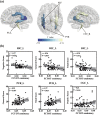Structure-function coupling in white matter uncovers the abnormal brain connectivity in Schizophrenia
- PMID: 37339983
- PMCID: PMC10281980
- DOI: 10.1038/s41398-023-02520-4
Structure-function coupling in white matter uncovers the abnormal brain connectivity in Schizophrenia
Abstract
Schizophrenia is characterized by dysconnectivity syndrome. Evidence of widespread impairment of structural and functional integration has been demonstrated in schizophrenia. Although white matter (WM) microstructural abnormalities have been commonly reported in schizophrenia, the dysfunction of WM as well as the relationship between structure and function in WM remains uncertain. In this study, we proposed a novel structure-function coupling measurement to reflect neuronal information transfer, which combined spatial-temporal correlations of functional signals with diffusion tensor orientations in the WM circuit from functional and diffusion magnetic resonance images (MRI). By analyzing MRI data from 75 individuals with schizophrenia (SZ) and 89 healthy volunteers (HV), the associations between structure and function in WM regions in schizophrenia were examined. Randomized validation of the measurement was performed in the HV group to confirm the capacity of the neural signal transferring along the WM tracts, referring to quantifying the association between structure and function. Compared to HV, SZ showed a widespread decrease in the structure-function coupling within WM regions, involving the corticospinal tract and the superior longitudinal fasciculus. Additionally, the structure-function coupling in the WM tracts was found to be significantly correlated with psychotic symptoms and illness duration in schizophrenia, suggesting that abnormal signal transfer of neuronal fiber pathways could be a potential mechanism of the neuropathology of schizophrenia. This work supports the dysconnectivity hypothesis of schizophrenia from the aspect of circuit function, and highlights the critical role of WM networks in the pathophysiology of schizophrenia.
© 2023. The Author(s).
Conflict of interest statement
The authors declare no competing interests.
Figures


References
-
- Pettersson-Yeo W, Allen P, Benetti S, McGuire P, Mechelli A. Dysconnectivity in schizophrenia: where are we now? Neurosci Biobehav Rev. 2011;35:1110–24. - PubMed
-
- Kanaan RA, Kim JS, Kaufmann WE, Pearlson GD, Barker GJ, McGuire PK. Diffusion tensor imaging in schizophrenia. Biol Psychiatry. 2005;58:921–9. - PubMed
-
- Fornito A, Zalesky A, Pantelis C, Bullmore ET. Schizophrenia, neuroimaging and connectomics. NeuroImage. 2012;62:2296–314. - PubMed
-
- van den Heuvel MP, Fornito A. Brain networks in schizophrenia. Neuropsychol Rev. 2014;24:32–48. - PubMed
Publication types
MeSH terms
LinkOut - more resources
Full Text Sources
Medical

